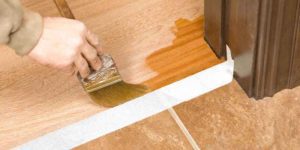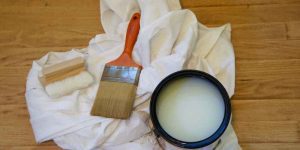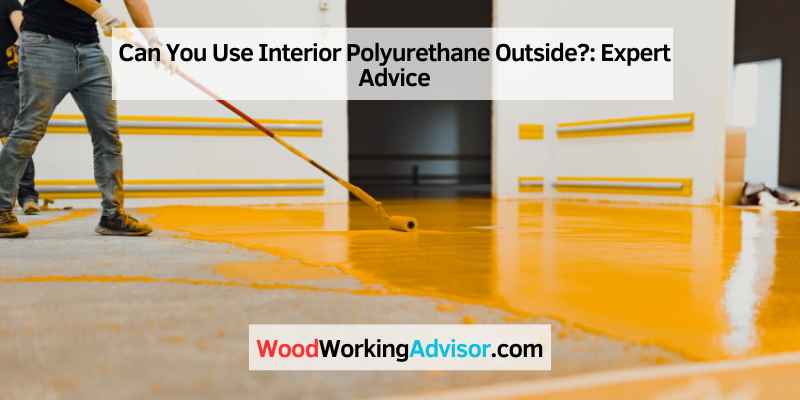In short, interior polyurethane should never be used outside, as it lacks the necessary additives to protect it from UV rays. Exterior polyurethane is formulated with these additives and is safe for outdoor use.
It’s crucial to use the right finish and protect your outdoor furniture, doors, windows, fences, railings, house trim, and boats above the waterline. We will discuss the difference between interior and exterior polyurethane, which one to use for outdoor projects, and what to consider before applying it.
We will also explore some of the best polyurethane sprays to protect your furniture and make it shine.
What Is Polyurethane And Its Types?
Polyurethane is a highly versatile polymer used in a wide range of applications. However, when it comes to using interior polyurethane outside, it’s important to note that interior polys should never be used outdoors as they lack the additives that protect exterior finishes from UV rays.
For outdoor projects, choose an exterior poly with additives for ultraviolet protection.
Introduction to Polyurethane:
Polyurethane is a synthetic resin that is widely used in various industries for its durability, versatility, and resistance to wear and tear. It can be used on a variety of surfaces, including wood, metal, and plastic. Polyurethane coatings are commonly used for interior furniture and floors. However, if you’re planning to use polyurethane outside, you might be wondering whether it’s a good idea or not. In this blog post, we’ll explore the types of polyurethane and whether you can use interior polyurethane outside.
Types of Polyurethane:
1. Water-Based Polyurethane:
A water-based polyurethane has a low VOC level, making it an environmentally friendly option for interior furniture. The finish is clear and dries quickly. It is also easy to clean. However, it’s not recommended for exterior use as it lacks the additives that protect against the UV rays of the sun.
2. Oil-Based Polyurethane:
Oil-based polyurethane is a popular choice for interior floors, doors, and furniture. It is more durable than water-based polyurethane and provides better protection from scratches, stains, and spills. It’s also more resistant to heat and chemicals. However, it’s not recommended for exterior use as it tends to yellow when exposed to the sun.
3. Moisture-Cure Polyurethane:
Moisture-cure polyurethane is an industrial-grade coating used for exterior surfaces, including boats, decks, and outdoor furniture. It’s more durable than oil-based or water-based polyurethane and can withstand harsh weather conditions. It’s also resistant to chemicals, stains, and spills. However, it’s difficult to apply, and it has a strong odor, so it requires a well-ventilated area for application.
Conclusion:
In conclusion, while polyurethane is a versatile and durable coating, you must use the right type for the right purpose. If you’re planning to use polyurethane outside, opt for a moisture-cure polyurethane that can withstand harsh weather conditions. Interior polyurethane lacks additives that protect against UV rays and should never be used outdoors.
The Difference Between Interior And Exterior Polyurethane
Using interior polyurethane outside is not recommended, as it lacks additives that protect exterior finishes from UV rays and other weather conditions. Exterior polyurethane, on the other hand, is specially formulated to provide protection from sunlight, water, and temperature changes.
It is essential to use the right type of polyurethane for your project to ensure durability and long-lasting results.
Interiors And Exteriors
Polyurethane is a versatile product that is commonly used for protecting and enhancing wooden surfaces. However, it is essential to know the difference between interior and exterior polyurethane before using it for the respective purpose. Interior polyurethane is designed to be used in indoor settings and does not contain UV blockers, additives, or other protective measures that can withstand outdoor conditions.
Exterior polyurethane is formulated to handle extreme weather conditions, sunlight, and moisture, making it the ideal choice for projects meant to withstand the elements.
Additives And Uv Protections
Exterior polyurethane has additional additives that provide greater UV protection against the sun’s harmful rays, making it more robust and durable than interior polyurethane. Moreover, it also resists cracking, chalking, and fading even under intense sunlight. Interior polyurethane, on the other hand, lacks these additional protective features, making it unsuitable for outdoor use. It is essential to read the manufacturer’s labels to determine which polyurethane type is suitable for your particular project.
In conclusion, it is evident that using interior polyurethane for outdoor projects is not recommended. The better alternative is to use exterior polyurethane, which is specifically formulated to provide adequate protection against the harsh outdoor weather. By using the right polyurethane type for the right project, you will achieve long-lasting and beautiful results that you will enjoy for years.
Can You Use Interior Polyurethane Outside?
Using interior polyurethane outside is not recommended as it lacks UV protection and ingredients to stand up against the elements. Exterior polyurethane or spar urethane is specially formulated to protect wood from sunlight, water, and temperature changes, making it the ideal choice for outdoor projects such as furniture, doors, and windows.
Polyurethane is a popular finish that adds durability and shine to wood surfaces. But can you use interior polyurethane outside? The short answer is no, it is not recommended to use interior polyurethane outside, as it lacks the necessary additives for protection against the elements.
Exterior Projects vs Interior Projects
Before we discuss the potential risks and issues of using interior polyurethane outside, it is important to understand the difference between exterior and interior projects. Exterior projects refer to surfaces that are exposed to sunlight, water, and temperature changes on a regular basis. These surfaces require protection from these elements to prevent damage. Interior projects, on the other hand, do not face the same types of environmental challenges and do not require the same level of protection.
Potential Risks and Issues
Using interior polyurethane outside can lead to a variety of issues, including peeling, cracking, and fading. Without UV protection and resistance to temperature changes, the finish will not be able to withstand the harsh outdoor environment. Over time, the wood may also become damaged and weakened, leading to further issues.
Expert Advice for Using Interior Polyurethane Outside
If you are considering using interior polyurethane outside, it is highly recommended to seek expert advice. A professional can recommend a suitable product for your project, as well as provide instructions on how to properly apply and maintain the finish. It is also important to properly prepare the surface before applying the finish, as this can impact the longevity of the finish.
In conclusion, it is not recommended to use interior polyurethane outside due to the potential risks and issues. It is important to choose a product that is specifically designed for exterior use to ensure the best protection and longevity for your wood surfaces.
Alternatives To Interior Polyurethane For Outdoor Use
Using interior polyurethane outside is not recommended since it lacks the necessary additives to protect it from UV rays. However, there are alternatives like exterior polyurethane, spar urethane, and varnish with UV resistance that are suitable for outdoor use. Choose the right product to ensure long-lasting protection for your outdoor furniture and projects.
If you are wondering whether you can use interior polyurethane outside, the short answer is no. Though interior polyurethane can provide an attractive and durable finish for interior wood surfaces, it is not suitable for outdoor use due to its lack of UV resistance and other protective additives.
However, there are several suitable alternatives to consider for outdoor use. In this section, we will explore suitable alternatives, benefits, and drawbacks associated with each, and expert opinions on their effectiveness.
Suitable Alternatives:
– Exterior Polyurethane: Unlike interior polyurethane, exterior polyurethane contains UV blockers and other additives to protect the surface from sunlight, moisture, and other outdoor elements. This type of polyurethane is suitable for all exterior wood surfaces, including decks, doors, windows, and outdoor furniture.
– Spar Varnish: Spar varnish is a popular alternative to polyurethane for outdoor use due to its superior UV resistance, flexibility, and ability to withstand temperature changes. It is ideal for wooden boats, patio furniture, and other exposed outdoor areas.
– Epoxy: Epoxy is a two-part coating that provides excellent protection against UV rays and moisture. It is suitable for outdoor surfaces such as garage floors, driveways, and outdoor furniture.
Benefits and Drawbacks:
Each alternative has its benefits and drawbacks. For example, exterior polyurethane is easy to apply, dries quickly, and provides a glossy finish, but it can yellow over time. Spar varnish has excellent UV resistance but can be challenging to apply and requires frequent maintenance. Epoxy is durable and long-lasting but requires careful surface preparation and may not be suitable for surfaces exposed to direct sunlight.
Expert Opinions:
According to experts, using interior polyurethane outside can lead to premature aging, cracking, and peeling of the surface due to sun exposure and other outdoor elements. On the other hand, exterior polyurethane, spar varnish, and epoxy are suitable alternatives that can provide better protection against UV rays and other outdoor elements. Experts recommend carefully assessing the surface’s use and exposure before choosing the right product for your outdoor project.
In conclusion, while interior polyurethane may be an excellent choice for indoor wood projects, it is not suitable for outdoor use. By considering suitable alternatives, benefits, and drawbacks associated with each, and expert opinions, you can make an informed decision and ensure the longevity and durability of your outdoor surfaces.

Tips For Choosing The Right Polyurethane For Outdoor Projects
When looking to polyurethane outdoor projects, it’s important to use the appropriate type of polyurethane. Interior polyurethane lacks UV protection and additives to handle weather changes and should never be used outdoors. Opt for an exterior polyurethane with ultraviolet protection for best results.
When it comes to outdoor woodworking projects, choosing the right polyurethane finish is crucial to ensure that your project is protected from the elements and looks great. Here are some tips for choosing the right polyurethane for outdoor projects.
Consider the Wood Type
Different types of wood require different types of polyurethane finishes. For example, if you’re working with a softwood like cedar or pine, you’ll want to use a finish that penetrates the wood fibers to provide deep protection. Hardwoods like oak and maple can benefit from a more durable, surface-level finish.
Look for Weather Resistant Additives
When choosing a polyurethane for outdoor use, look for products that contain weather-resistant additives. These additives help protect your project from UV rays, water damage, and temperature fluctuations.
Choose a Gloss Finish
In general, gloss finishes tend to protect your woodworking projects more effectively than satin or matte finishes. Gloss finishes are more durable and less likely to crack, peel, or fade over time.
Check the Label for UV Protection
UV rays from the sun are a major contributor to wood degradation and color fading. Look for a polyurethane finish that includes UV protection additives specifically designed for outdoor use.
By following these tips, you can choose the right polyurethane finish for your outdoor woodworking project and ensure that it looks great and lasts for years to come.
How To Apply Polyurethane For Outdoor Projects
Using interior polyurethane for outdoor projects is not recommended as it lacks the necessary additives to protect it from UV rays and weather. Instead, opt for an exterior polyurethane or a water-based spar urethane to ensure proper protection and durability for your outdoor furniture or projects.
Polyurethane is a versatile finishing material that can be used for woodworking projects both indoors and outdoors. Applying polyurethane to outdoor projects can help protect them from the elements and promote longevity. However, not all types of polyurethane are suitable for outdoor use, and applying the wrong type can result in poor finish quality and a lack of protection from UV rays.
Surface Preparation
As with any woodworking project, proper surface preparation is essential when applying polyurethane for outdoor use. Before applying polyurethane, you should ensure that the surface is clean, dry, and free of any dirt, dust, or debris. Use sandpaper to remove any rough spots or splinters and wipe the surface clean with a damp cloth.
Application Techniques
When applying polyurethane for outdoor projects, you can use a brush, roller, or spray gun. Brushing or rolling is often the preferred method for elaborate or curved surfaces, while a spray gun is better suited for large, flat areas like outdoor furniture. The direction of application should be consistent, either horizontal or vertical.
Tips for Brushing or Rolling
When brushing or rolling polyurethane, it’s essential to use long and even strokes to avoid lumps or air bubbles. You should also work in small sections to maintain wet edges and ensure an even finish. If you notice any drips or bubbles, smooth them out with a brush or roller before the polyurethane dries.
Drying and Curing Time
The drying and curing time of polyurethane for outdoor projects can vary depending on the type of polyurethane and the weather conditions. In general, it takes 24 hours for polyurethane to dry and 72 hours to cure. However, if the temperature is too cold or the humidity is too high, the curing process may take longer.
In conclusion, applying polyurethane for outdoor projects requires proper surface preparation, the right application technique, and sufficient curing time. By following these tips and using the appropriate type of polyurethane, you can ensure that your outdoor woodworking projects will be well-protected and long-lasting.
Maintenance For Polyurethane Finishes On Outdoor Projects
Using interior polyurethane outside is not recommended as interior polyurethane lacks additives that protect exterior finishes from UV rays. Look for a finish specially formulated for exterior use and with additives for ultraviolet protection. Proper maintenance is essential to ensure longevity for polyurethane finishes on outdoor projects.
Preventive Measures To Extend The Life Of The Finish
Using interior polyurethane for outside projects has become a popular choice for many homeowners due to its protective properties. However, it’s important to note that interior polyurethane isn’t specially formulated to withstand extreme weather conditions. Therefore, it’s essential to take preventive measures if you want to extend the life of your outdoor project’s finish.
Cleaning And Reapplication Strategies
To maintain your polyurethane finish’s quality, you will need to clean and reapply the finish regularly. If you notice any damage to your finish, it’s crucial to repair it promptly. Follow the below guidelines to care for your outdoor projects effectively:
- Clean the surface twice a year using warm water and a mild detergent. Avoid using abrasive cleaners or solvents as they can damage the polyurethane finish.
- After cleaning, apply a fresh coat of the polyurethane finish to protect the surface from weather conditions.
- Ensure that the surface is free of dust and debris before recoating.
- Use a synthetic brush to apply a thin layer of the finish. Avoid applying it too thickly, as it can lead to peeling or bubbling in the future.
- Let the finish dry for 24 hours before using the surface.
Remember, polyurethane finishes are ideal for protecting your outdoor project, but they require regular maintenance to maintain their effectiveness. With proper care, you can prolong your project’s life and keep it looking great for years to come.

Frequently Asked Questions Of Can You Use Interior Polyurethane Outside
Can I Use Minwax Polyurethane Outdoors?
Yes, Minwax® Helmsman® Spar Urethane can be used outdoors as a protective clear finish for interior and exterior wood exposed to sunlight, water or temperature changes. It is specially formulated for exterior use and can provide UV, weather, and water resistance.
Can I Use Interior Varnish Outdoors?
No, interior varnish does not have the same UV resistance as exterior varnish to withstand the elements. However, you can add a clear varnish layer over something that has previously been varnished or stained. It’s best to use exterior varnish or polyurethane with additives for UV protection if you plan to use it outdoors.
Can Water Based Polyurethane Be Used Outdoors?
Yes, water-based polyurethane can be used outdoors. Look for a finish that contains additives for UV protection and is labeled for exterior use. These finishes are ideal for all types of outdoor projects, including outdoor furniture, doors, windows, fences, railings, house trim, and boats (above the water line).
Varathane Outdoor Water-Based Spar Urethane is one such example.
Will Polyurethane Last Outside?
Polyurethane can be used outside if it contains ingredients for UV protection and is labeled for exterior use. Interior polyurethane lacks the additives needed to shield finishes from UV rays and should never be used outside. Look for a finish that dries flexible to accommodate the expanding and contracting wood.
Conclusion
It is important to select the appropriate type of polyurethane for your project, whether it is for interior or exterior use. Interior polyurethane should not be used outside as it lacks the necessary additives to protect it against UV rays and weather changes.
However, several manufacturers offer exterior polyurethane options that provide the required protection, making them suitable for outdoor use. It is vital to carefully read the labels and choose the right product to achieve long-lasting and beautiful results.


